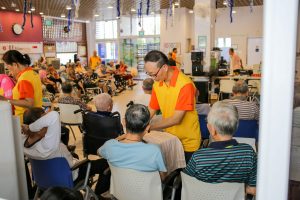How Community-Based Eldercare Services Adapt in Response to Covid-19 Restrictions: Evidence from Singapore
March 10, 2023

Community-based eldercare services (CES) form an indispensable part of intermediate-long term care services in Singapore. They reduce the strain on public hospital resources by providing community care and outpatient services. CES comprise centre-based, home-based, and residential-based services. They mainly serve frail community-dwelling older adults (OAs) who require assistance with daily needs, or supervision and rehabilitation. As care preferences shift away from institutionalisation, there has been increasing demand for CES.
During the COVID-19 pandemic, the virus was found to be transmitted frequently among older adults who participated in social activities and gatherings. As such, from 11 March 2020, senior-centric activities were suspended, physical visits were limited, infection control measures were implemented, group activities were reorganized, and remote contacting of non-urgent cases was introduced. These restrictive activities forced CES to re-examine and adapt existing service delivery methods to ensure service continuity.
In ‘How Community-Based Eldercare Services Adapt in Response to Covid-19 Restrictions: Evidence from Singapore’ (Journal of Gerontological Social Work, 2022), Ms Charmaine Yun Lin Cheng (Kreta Ayer Family Services) and Assistant Professor Nan Jiang (formerly NUS Department of Social Work) examine the different adaptation strategies CES in Singapore adopted in view of the COVID-19 pandemic restrictions.
By conducting 11 semi-structured interviews with social service staff from various CES in Singapore, Ms Cheng and Asst Prof Jiang found that across the board, there was increased engagement with clients and relevant stakeholders. Due to limited resources and COVID-19 restrictions, CES workers had to reprioritise their service users, with some compiling lists of those who needed more help. There was also increased liaison with volunteers, who assisted with meeting OAs’ social needs by providing tele-befriending and basic tele-counselling services, which enabled workers to monitor service users’ well-being. In addition, they assisted with brainstorming of ideas and facilitation of new online programs to reduce the workload of staff. When ill-equipped to meet needs, referrals were made to other service providers.
There was also increased use of video calls on WhatsApp and Zoom, although voice telephone calls were most often used with OAs. This led to perceived enhancement of social connectedness and social engagement, as well as new opportunities for CES to review operations and tap on increased visibility of service users.
However, difficulties using telecommunications, resource constraints, and work stressors remained. For example, some workers had difficulties building rapport with new service users over the phone. With restrictions on group sizes, CES workers also faced the problems of having insufficient manpower, time, space, essential supplies, and technological equipment. They also encountered a heavier workload during the pandemic, although having regular team meetings that encouraged staff to update one another, discuss concerns, and problem-solve together, along with higher management giving clear directions and providing additional welfare resources, helped tide them over tough times.
Therefore, it is recommended that CES providers implement supportive workplace practices, complement direct service provision with technology, and leverage on opportunities to improve the social environments of community-dwelling older adults.
Read the article here.
